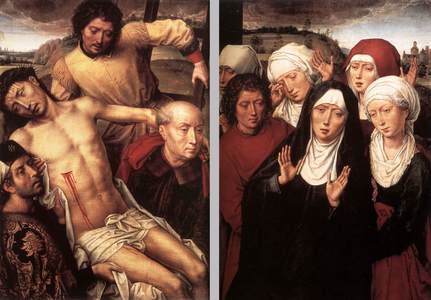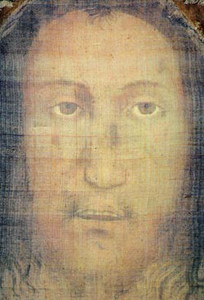A claritate in claritatem

The Martyrology
We are, at every moment, surrounded by “so great a cloud of witnesses” (Heb 12:1) who encourage us by their example and support us by their prayers. This is why the Church, in her wisdom, invites us every day to open her Martyrology and to become familiar with those whose intercession is an unfailing pledge of divine assistance. Opening to the first entry for August 31st in the Roman Martyrology, we read:
At Jerusalem, the commemoration of Saints Joseph of Arimathea and Nicodemus, who received the body of Jesus taken down from the cross, wrapped it in a shroud and placed it in the sepulchre. Joseph, a noble official and disciple of the Lord, was seeking the Kingdom of God; Nicodemus, for his part, a member of the Pharisees and a ruler among the Jews, came to Jesus by night to inquire of his mission and defended him in the presence of the high priests and Pharisees who sought to arrest him.
One also reads in the 2004 edition of the Roman Martyrology the following provision at Article 30:
The Mass and also the Office of any Saint inscribed in the Roman Martyrology . . . may with just cause be celebrated on the day whereupon the name is inserted, when that day is a feria or when an optional memorial is permitted.

Holy Men
We have just cause and good reason to celebrate Saints Joseph of Arimathea and Nicodemus today. The Gospels associate them with the Mother of God and those other saints so dear to us, who in sorrow and compassion stood by the Cross of Jesus and who, after His death, looked upon the Prince of Life’s wounded hands and feet and side. Some of the most poignant iconography of Our Lord depicts His removal from the cross and burial. We see the Body of Jesus carried in the winding sheet, the shroud of linen prepared by Joseph. We see the Blessed Virgin, Saint John, Mary Magdalene, and the other holy women. And with them we see two noble men with expressions of tenderness and grief: Joseph of Arimathea and Nicodemus.
In the Gospels
There is more written about Joseph of Arimathea and Nicodemus in the Gospels than there is about most of the Apostles. Meditating on the Gospel texts that speak of them we discover two men intimately bound to Our Lord, not only during His active life but also in the mysteries of His death and burial. We see two men who actively sought the Kingdom of God, two men who came to the Son because they were drawn to Him by the Father in the Holy Spirit. “No man can come to me, unless it be given him by my Father” (Jn 6:66).
Saint Nicodemus
Read again the dialogue of Our Lord with Saint Nicodemus in Chapter 3 of Saint John’s Gospel. It is to Nicodemus that Jesus reveals the mystery of the Cross, saying: “And as Moses lifted up the serpent in the desert, so must the Son of man be lifted up: That whosoever believeth in Him, may not perish; but may have life everlasting.” (Jn 3:14). Again, it is to Nicodemus that He reveals the Father’s redeeming love, saying: “For God so loved the world, as to give His only begotten Son; that whosoever believeth in Him, may not perish, but may have life everlasting.” (Jn 3:15).
These inexhaustible sayings of Our Lord were first sown in the heart of Nicodemus in the course of that extraordinary secret conversation by night. Where did the Fourth Evangelist obtain knowledge of these sayings if not from Nicodemus himself? If we would penetrate these sayings and allow them to transform us, we do well to seek the intercession of the man to whom they were first addressed: Saint Nicodemus.
Saint Joseph of Arimathea
Saint Joseph of Arimathea is named in all four Gospels. Saint Luke calls him “a good and just man” (Lk 23:50). Saint John tells us that he was “a disciple of Jesus, but secretly, for fear of the Jews” (Jn 19:38). How extraordinary then, that after the death of Jesus, Joseph should overcome his fear and become so bold as to ask Pilate “that he might take away the body of Jesus” (Jn 19:38). Saint John goes on to say that, “And after these things, Joseph of Arimathea (because he was a disciple of Jesus, but secretly for fear of the Jews) besought Pilate that he might take away the body of Jesus. And Pilate gave leave. He came therefore, and took the body of Jesus. And Nicodemus also came, (he who at the first came to Jesus by night,) bringing a mixture of myrrh and aloes, about an hundred pound weight. They took therefore the body of Jesus, and bound it in linen cloths, with the spices, as the manner of the Jews is to bury.” (Jn 19:38-42).
Shroud and Napkin
According to the Gospel accounts of the burial of Our Lord, we are indebted to Saints Joseph of Arimathea and Nicodemus for those precious relics of the Passion of the Lord: the Sacred Shroud, and the Veil of the Holy Face that Pope Benedict XVI venerated with such piety on the occasion of his pilgrimage to Manoppello on September 1, 2006. It is fitting then that we should ask through the intercession of Saints Joseph of Arimathea and Nicodemus, that we may learn to contemplate those mysterious images of the Holy Face of Jesus imprinted on “shroud and napkin.”
The Holy Face
One cannot gaze upon the beauty, the majesty, the serenity, and the tenderness of the Face of Christ without being inwardly changed. This is the secret of sanctification. We do become what we contemplate. “But we all beholding the glory of the Lord with open face, are transformed into the same image from glory to glory, as by the Spirit of the Lord” (2 Cor 3:18). Saints Joseph of Arimathea and Nicodemus, pray for us that, with eyes of faith and tears of compunction, we may gaze upon the Face of Christ!
